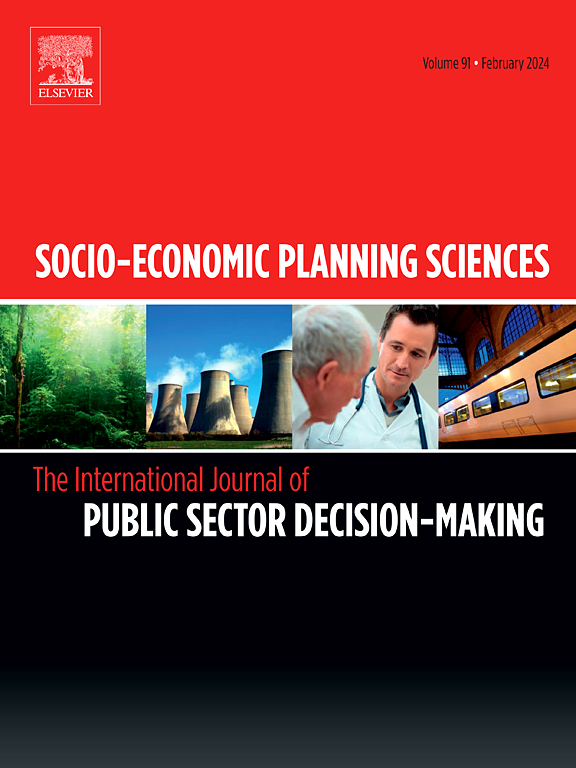An Innovative Approach to Efficiency Measurement: Combining Convexified Efficiency Analysis Trees and Data Envelopment Analysis to Benchmark U.S. Museums
IF 5.4
2区 经济学
Q1 ECONOMICS
引用次数: 0
Abstract
This study evaluates for the first time the efficiency of U.S. museums using a novel combination of Convexified Efficiency Analysis Trees (CEAT) and Data Envelopment Analysis (DEA). While DEA is widely used for efficiency measurement, it suffers from overfitting and limited discriminatory power in high-dimensional datasets. CEAT addresses these issues by integrating machine-learning techniques with production theory, providing interpretable and robust benchmarks. By categorizing museums into clusters based on input-output profiles, the analysis reveals distinct efficiency patterns across museums of varying sizes and operational foci. The results highlight CEAT's superior ability to differentiate efficiency levels, offering actionable insights into input reductions and output increases for underperforming museums. Specifically, the analysis classifies museums into four clusters according to their size. The first three comprise the largest, medium-large and medium sized museums, while the last cluster constitutes a subtree including smaller museums. It is further divided into several branches according to specific inputs like limited or extensive program expenses (budgets), and short and long opening hours, respectively correlating with non-commercial versus market-oriented business models. Peer benchmarks identified within clusters further guide managerial strategies for improvement. The largest museums can improve efficiency by reducing opening hours or program expenses, while medium-size museums would benefit from reducing staff size and gallery space. As for relatively smaller museums in terms of visitors, besides opening hours, reducing total compensation would also result in greater efficiency. This shows that one-size-fits-all recommendations for museums’ efficiency improvement do not apply, adding diversity to the results obtained in previous literature.
效率测量的创新方法:结合凸化效率分析树和数据包络分析以基准美国博物馆
本研究首次使用凸化效率分析树(CEAT)和数据包络分析(DEA)的新颖组合来评估美国博物馆的效率。虽然DEA被广泛用于效率度量,但它在高维数据集上存在过拟合和判别能力有限的问题。CEAT通过将机器学习技术与生产理论相结合来解决这些问题,提供可解释和健壮的基准。通过基于投入产出概况将博物馆分类为集群,分析揭示了不同规模和运营重点的博物馆之间不同的效率模式。结果突出了CEAT区分效率水平的卓越能力,为表现不佳的博物馆提供了减少投入和增加产出的可行见解。具体来说,该分析根据博物馆的规模将其分为四个集群。前三个集群包括最大的、中型的和中型的博物馆,而最后一个集群构成了一个子树,包括较小的博物馆。根据具体的投入,如有限或广泛的项目费用(预算),以及短和长的开放时间,它进一步分为几个分支,分别与非商业和市场导向的业务模式相关联。在集群内确定的同行基准进一步指导改进的管理战略。最大的博物馆可以通过减少开放时间或项目费用来提高效率,而中等规模的博物馆则可以通过减少员工人数和画廊空间来受益。对于参观者相对较少的博物馆,除了开放时间外,减少总补偿也会提高效率。这表明一刀切的博物馆效率提升建议并不适用,增加了以往文献结果的多样性。
本文章由计算机程序翻译,如有差异,请以英文原文为准。
求助全文
约1分钟内获得全文
求助全文
来源期刊

Socio-economic Planning Sciences
OPERATIONS RESEARCH & MANAGEMENT SCIENCE-
CiteScore
9.40
自引率
13.10%
发文量
294
审稿时长
58 days
期刊介绍:
Studies directed toward the more effective utilization of existing resources, e.g. mathematical programming models of health care delivery systems with relevance to more effective program design; systems analysis of fire outbreaks and its relevance to the location of fire stations; statistical analysis of the efficiency of a developing country economy or industry.
Studies relating to the interaction of various segments of society and technology, e.g. the effects of government health policies on the utilization and design of hospital facilities; the relationship between housing density and the demands on public transportation or other service facilities: patterns and implications of urban development and air or water pollution.
Studies devoted to the anticipations of and response to future needs for social, health and other human services, e.g. the relationship between industrial growth and the development of educational resources in affected areas; investigation of future demands for material and child health resources in a developing country; design of effective recycling in an urban setting.
 求助内容:
求助内容: 应助结果提醒方式:
应助结果提醒方式:


